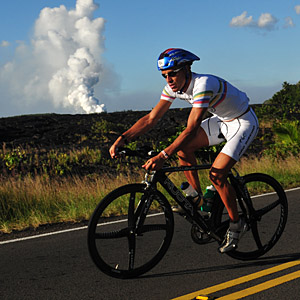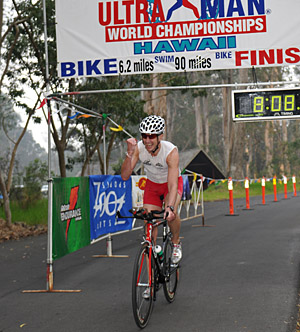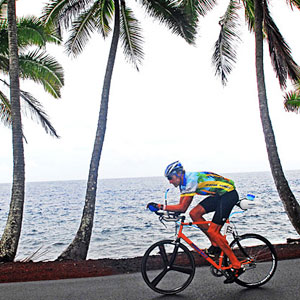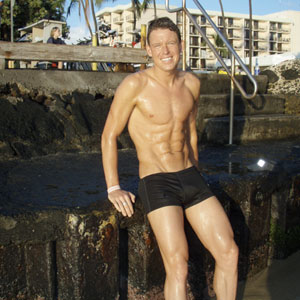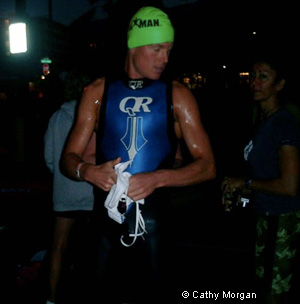Kipling’s Ultraman
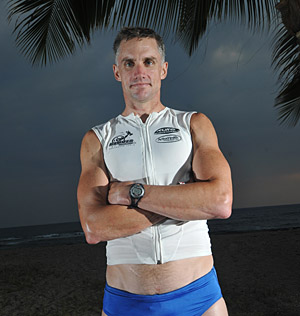
Rudyard Kipling said it all: " If you can meet with Triumph and Disaster and treat those two Impostors just the same; Yours is the Earth and everything that's in it."
The educator of warriors
Lieutenant Colonel Tony O'Keefe is in charge of 1,054 cadets at Canada's version of West Point. It is his job to prepare men and women to go into battle in the world of terrorist ambushes, in the very cruel lands that Rudyard Kipling wrote about, and act with the highest levels of integrity when life and death are separated by a rusty razor's edge. And so on the field of play on the Big Island of Hawaii in a rigorous three-day aerobic adventure called Ultraman, O'Keefe keeps his cool whether things are going well or poorly. "At age 47, sure it hurts," says O'Keefe, who sports a missing front tooth from a hockey collision as a youth. If not for a few grey hairs, he could pass for 20 years younger, if not quite for one of his cadets. "I'm getting older," he says. " It's great to be here racing against top professionals, but I never take anything for granted."
O'Keefe led the field in the first day's 10k swim and 90 mile bike. But he knew better than to gloat. "This thing can backfire and end up in a disaster," said O’Keefe. "All these guys are stronger athletes. My strength is mental."
On Sunday, the third day of this post-Thanksgiving, 320-mile triathletic circumnavigation of the Big Island of Hawaii, O'Keefe let three men go early in the morning on the double marathon heading south from Hawi to Kailua along the Queen K Highway made famous in October's Ironman. A lesser man might have overreached and tried to stay with the blazing trio headed for a 2:57 first marathon, but O'Keefe knew his best day from four years ago was a pair of 3:12s. And a lesser man might have looked at his three straight runner-up finishes from 2002 through 2004 and lost his head in pursuit of vain glory. A lesser man might even have been bitter that a year long deployment to Sarajevo cost him training and a more immediate rematch with Ultraman, just as his peak athletic years were slipping away. A lesser man might even have wasted adrenaline worrying about the footsteps of 1996 Ultraman champion Erik Seedhouse, just three years younger and one of two men to break 6 hours during the Ultraman double marathon, stalking him from behind.
But instead, Tony O’Keefe followed the famous maxim of Clint Eastwood’s Dirty Harry: “A man’s got to know his limitations,” and kept his own counsel, running a conservative downhill first half marathon – 1 hour 30 minutes to the leaders’ 1:26. Knowing the reality of the battlefield, O’Keefe said, “Things can always get worse.”
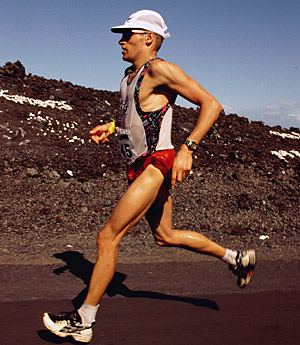
The aerospace physiologist confronts a competitive space-time discontinuum
Erik Seedhouse is a scientist who works for the Canadian Forces Environmental Medicine. Part of his job is to figure out ways for astronauts to stay healthy and alive on a future mission to Mars. He also was examining the ethical and moral issues involved in such a risky endeavor.
From 1996 through 1998, Seedhouse was an Ultra star, winning the Monterrey, Mexico Deca-Ironman test and taking the 1996 Ultraman with a closing 5:57 double marathon. Then, in 1999, he retired from professional sports at age 35. "When you're a professional, it really takes it out of you," he says. "There's the psychological pressure of being one injury away from oblivion. And being in a fringe sport, where you have to fight tooth and nail for all your sponsorships, you have to be your own manager, your own coach, and your own PR person. That's a huge amount of pressure."
Nine years later, he relented to the urging of his old support crew and entered Ultraman Hawaii, thinking the pressure might be off and he could enjoy the beauty of the island and the camaraderie of the Ultraman family led by race director Jane Bockus. Still a proud man, he was leery. "You can't go from a professional to an also ran. It's very very difficult."
So that is why in February he took his bike out of mothballs for the first time in nearly a decade and hit the pool and the trails. As a scientist intimately familiar with the limitations of human physiology, Seedhouse knew that at age 44 – with no racing for a decade — it would be hard to recalibrate. "This spring, I won the Canadian Forces half marathon in 1:19, which have me an indication that my running was OK." he said. "But that's just one-fourth of the Ultraman distance. And you have to save your legs through 261 miles of biking and 15,000 feet of climbing.”
So when he teed it up on the Friday after Thanksgiving, Seedhouse felt the inner pressure building again. "My mind is still calibrated to 10 years ago," he said. "It's very difficult to restrain yourself. This is my first Ultra distance event in 10 years, so it is hard to gauge how quickly to go out." So it sounded overly modest when he said the fastest he could run would be 7 hours. But to himself, the aim was more modest. "My goal is 7 hours 30 minutes."
True to his plan, Seedhouse ran the first 13.1 miles in 1:47:27 – 21 minutes slower than the leaders. He finished the first marathon in 3:48:30, 51 minutes back of the two leaders. Then he hit a dark spot where he had to walk a few sections, something he'd never done as a pro.
When it was over, Seedhouse ran 8:03:59 and placed 6th. Like an astronaut after a long stint in space, the once high flying Ultra star had returned to terra firma to take his place with the merely human athletes.
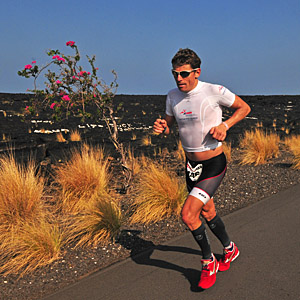
The return of the prodigal Ultraman
At age 36, Peter Kotland had never retired from his sport. He'd just never gone back to Ultraman – at least as a competitor – after his epochal 5:33:57 double marathon run and the victory. Kotland had gone back to Kona to crew for one modest age grouper, then returned to serve as support crew for one spectacular athlete he was coaching –four-time winner Shanna Armstrong of Texas.
During his Ultraman hiatus, Kotland said it took him year to recover from the physical strain of that bright, shining run. “I could not sleep for three days after the race," he recalls. If prodded, he will admit he had aggravated his Achilles, running so far so fast on asphalt. Armstrong says of her coach and Ultraman mentor, "Peter shredded his Achilles." Kotland says, "It bothered me for 4-5 years, but it's been fine since then." Perhaps that explains his modest record at the four or five Ironmans per year that has made up his professional diet since. His best performance was an 8:28 at Ironman Hawaii one fast year at Kona. In another year at there, he took third place in overall age group behind Troy Jacobson. At Ironman California in 2000, he took third overall behind Chris Legh. He took 5th at Ironman Lake Placid in 1999, 4th at Ironman Florida in 2001, and another 5th at Ironman Wisconsin. This summer, he took 9th at Ironman Louisville and then, suffering an eardrum infection incurred in dirty water at a local South Carolina race, suffered through a painful outing at Ironman Florida and barely made it to the Ultraman start with the help of antibiotics.
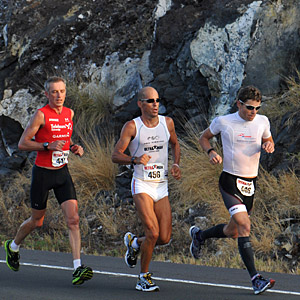
When Ultraman 2008 started, Kotland was back from the future. On day one, adverse currents made everyone push harder to get through to the finish at Keauhou Bay. Kotland made it in 3:19:58 – 25 minutes slower than his 1997 time. "I think I got dehydrated on the swim, and made it worse when I pushed on the bike," he said. He finished his ride with the fourth-best bike split of 5:18:03 – six minutes slower than 1997. Rewarded with tailwinds on Day 2’s 171.4 mile bike leg, Kotland hung with Alexandre Ribeiro for 140 miles, then finished off with a fourth-best-ever 7:29:27 leg, 43 minutes faster than 1997. Overall, he was 12 minutes faster than his old pace, but Kotland the exercise physiologist knew better than to give in to false hopes for a reprise and a possible course record.
"On that first day, I started to get dehydrated on the swim and cramped up," he said. "And went even deeper into debt pushing hard on the bike. The first day seemed OK because when we finished at Volcanoes it was cooler, so I didn't think it bothered me. But the second day, it got hot on the ride and I started to have stomach issues after the ride. I just think once you start to get dehydrated in a stage race, you can't catch up."
Still, he retained his natural optimism starting the fateful run. "I let the guys go because I thought they were going a little fast and I need some time to get warmed up," he recalls. While Ribeiro and Miro Kregar ran the first 10 miles at a fast 6:03 pace, Kotland joined them about Mile 8. While the downhill from Hawi makes it easy to go fast, the pounding on the legs is like a high interest loan. Still, Kotland was not cruising when he joined the duo. "Good morning Peter!" said a cheerful Ribeiro. "Come run with us!" Still, the Brazilian noted that the legendary 5:33:57 Man was struggling. "I could hear Peter breathing hard," said Ribeiro. "That couldn’t be good."
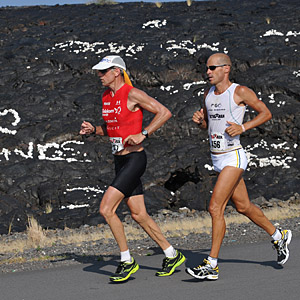
So Kotland dropped off and trailed by a 3:51 margin at Mile 13.1. Hr held steady through the first marathon, where Kregar and Ribeiro finished in 2:57:54 to Kotland’s 3:02:10, with O'Keefe another 9 minutes back. In his mind, Kotland felt comfortable. "I run like a diesel – my second marathon is faster than my first."
Based on past results, his rivals could not maintain the pace – Kregar's best Ultraman run was 6:27:58 last year. Ribeiro's was 6:38:53 last year. After Day 2, Kotland was 31 minutes back of Ribeiro, 21 minutes back of O'Keefe, and 16 minutes ahead of Kregar. "I thought I'd catch them," said Kotland.
While it had become increasingly unlikely he could surpass the obviously superbly fit and on-form Brazilian for the overall, a 6-hour run looked doable for a healthy Kotland.
In the first few miles of the second marathon, Kotland whittled the margin to 3:15. Then, at Mile 30, reality hit. "The lights went out," said Kotland. "It was the accumulation of the first two days. It was extreme dehydration and it went from my stomach to my legs. My crew tried every trick in the book, to get me going – they gave me more electrolytes, changed it up with some gels, and tried Alka-Seltzer to settle my stomach. But there is only so much you can do."
Walking much of the way, Kotland struggled mightily to the end. "At that point, I think I pushed the hardest in my life," said Kotland. "I gave it all I had. One hundred percent. Including my heart and soul."
Somehow he managed to hit the line with a run of 7:33:20. It was almost precisely two hours slower than his 2008 moment, but no less glorious by the Ultraman yardstick. "Everybody knows there is no worldwide fame of it," said Kotland. "Who even dares to come here and attempt to do this race has a huge inner strength. When you get one of those hard days, you just have to dig so deep. I think that's why you don't see people not finish Ultraman."
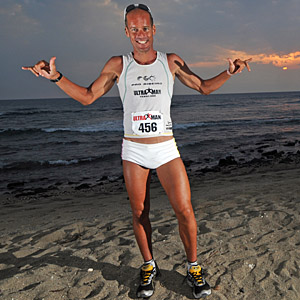
Indeed, Suzy Degazon, one-armed artist and long distance triathlete veteran Jason Lester, Marty Raymond, and Scott Gower all suffered painful jellyfish stings and soldiered on. Kelly Duhig of Australia was hit harder and required medical attention and had to drop out.
At the finish, facing the twin impostors
As it worked out, Alexandre Ribeiro had the race of his life and came within eight minutes of Holger Spiegel's 1998 course record. With the overall race in hand, he let Miro Kregar race ahead with 10km to go to claim the best run of the day. Kregar had to be happy. His 6:14:16 run beat his personal best by 13 minutes and was the fifth fastest in the race's history. Ribeiro, proudly sharing the honor of the day with his young son Kailani serving on his support crew, was happiest of all. "It was my best race ever – at age 43!" he said. "I think I won it training on the hills near Rio de Janeiro – Teresopolis, Itaipava, Petropolis. Some days I train 11 hours there."
O'Keefe took great satisfaction in his fourth straight second place finish – "My cadets now know I did the job. Second place? It's a delightful confirmation!"
That last minute sprint away from his running partner was not an unfriendly abandonment after 45 miles of good company. The surge gave Kregar a 3-minute advantage on Kotland for the final podium slot at age 46. And if Kregar had run harder, O'Keefe was just another 3 minutes ahead in second place. Ribeiro's 6:15:32 run was a PR by 23 minutes and a crowning achievement made possible, he says, by peace of mind.
"I have two ex-wives now," he says. "Only this year there is peace. Now I take full responsibility for my son Kailani and my two other children. I work hard coaching 100 athletes, teaching spin classes, and guiding other triathletes. I take full responsibility for my family and my sport – I paid for myself and my crew and my son to come here to the race I love."
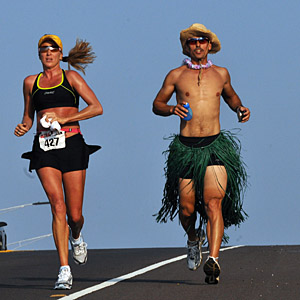
Even when he lay on a bench at the finish line for two hours, ice packs on his neck, legs, and torso, Kotland was not ultimately discouraged. "Some people take victory and they learn from it a lot," said Kotland. "But I usually take the defeats to motivate me even more. That's my personality. That's what makes me stronger. I will look at this race and figure out what went wrong and I will be back next year motivated to have a great race."
Women's winner Shanna Armstrong might have been disappointed when two-time Ultraman winner Monica Fernandes pulled out with the flu. But instead, she and Peter Mueller romped through the run cracking jokes, trading gossip, and goofing on friends like Josef Ajram, humming the theme from "Jaws" when they passed him on the run.
"Some people think only competition can motivate you," said the 34-year-old Armstrong. "It's the good energy that gets me to the finish line, not trying to jack me up by telling me that somebody's two minutes back or two minutes ahead. No! We're all family. I need positive stuff. Not people saying we're going to get you!"
Armstrong says it's not the thrill of victory that brings her back every year – it's the Ultraman family.
"I know some day somebody is going to show up and beat me. I'm ready for that. But no matter what, I'm coming back for 20 dadgum years. I'll be a wrinkled old prune, but they'll never get rid of me."
24th Ultraman World Championship
November 28-30, 2008
The Big Island, Hawaii
S 6.2 mi/ B 90 mi./ B 171.4 mi./ R 52.4 mi.
Final Results
Men
1. Andre Ribeiro (BRA) Swim 3:12:00 (7) Bike 1&2 12:22:06 (1) Run 6:15:32 (2) 21:49:38
2. Tony O'Keefe (CAN) Swim 3:04:06 (6) Bike 1&2 12:40:40 (3) Run 6:46:58 (4) 22:31:51
3. Miro Kregar (SLO) Swim 3:19:53 (16) Bike 1&2 13:06:00 (5) Run 6:14:16 (1) 22:35:24
4. Peter Kotland (CZE) Swim 3:19:53 (12) Bike 1&2 12:45:30 (4) Run 7:33:20 (5) 23:38:48
5. Carlos Conceicao (BRA) Swim 3:29:27 (14) Bike 1&2 14:11:42 (9) Run 6:46:28 (3) 24:27:17
6. Erik Seedhouse (CAN) Swim 2:55:53 (3) Bike 13:37:16 (7)) Run 8:03:59 (7) 24:37:08
7. Josef Ajram (ESP) Swim 3:35:03 (16) Bike 12:31:50 (2) Run 8:33:45 (11) 24:40:38
8. Scott Gower (USA) Swim 3:03:39 (5) Bike 1&2 13:56:03 (8)Run 8:24:46 (10) 25:24:28
9. Peter Mueller (SUI) Swim 3:14:33 (10) Bike 1&2 14:33:18 (10) Run 8:17:14 (9) 26:05:05
10. Richard Roll (USA) Swim 2:41:28 (2) Bike 1&2 14: 51:42 (12) Run 9:00:32 (15) 26:33:42
Men
1. Shanna Armstrong (USA) Swim 3:02:44 (1) Bike 1&2 15:05:06 (1) Run 8:17:13 (1) 26:25:03
2. Suzy Degazon (USA) Swim 4:59:08 (3) Bike 1&2 16:22:47 (2) Run 10:01:57 (2) 31:23:52
3. Catherine Paulson (USA) Swim 4:37:33 (2) Bike 1&2 16:52:33 (3) Run 11:16:11 (3) 32:48:22
DNF Leslie Holton (USA) Swim 5:46:58 (4) Bike 1 DNF Run 11:48:12 (4)



